At some point in the summer, I wrote PIE SEASON on the wall calendar next to October 16th. In case you’re wondering where this season and its official start date come from, I made it up. It was too hot to make pies when I got a nice new baking dish and pie bird, so I declared pie season for when I estimated it would be cooler. And when I say pie season, I mostly mean savory pies.
Why meat pie #
I have not grown up with savory pies, so for me they are a series of tasty experiments. However, my spouse is English and grew up eating them. So as an additional constraint, I’m choosing traditional pies and sticking to the recipes to create a homey feeling.
Meat pies are quite time consuming. On the other hand, you can make stuff ahead, and also you can make a whole lot and eat reheated pie for a few days.
Pie season has been going for a bit over a month, and I wanted to compile the scattered posts I've made about pies into one place.
Cottage pie #
My first pie of pie season was cottage pie. I started off easy without the pressure of a crust.
I followed the recipe for cottage pie from BBC Good Food. I made a third of the recipe and it was still a ridiculous amount of food. I don't know who writes these recipes, but it seems like they assume you are feeding a very hungry family of 10.
I did not get any photos of the cottage pie. Honestly it's not that photogenic. It's a pile of mashed potatoes on top of a layer of ground beef. The effort-to-deliciousness ratio of this recipe is excellent.
Steak and onion pie #
My second pie was steak and onion. It upped the challenge level as steak and onion pie requires a pastry top, however not yet a pastry bottom.
I followed the recipe for steak pie from BBC Food.
The second pie of pie season was a lot more labor-intensive, not just because of the crust but also because cooking the beef and onion filling took several hours. In retrospect, I should have browned the meat and then shoved the lot into a slow cooker. The pie bird does worked well at keeping the crust from getting soggy.
The effort-to-tastiness ratio was also very good. Of all the pies I've made so far, I think this was the most delicious. I'll almost certainly make it again.
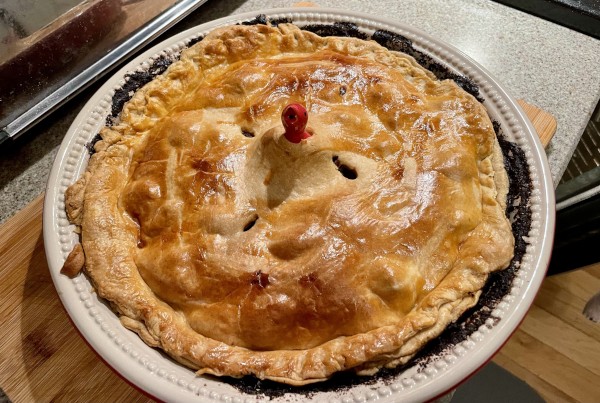
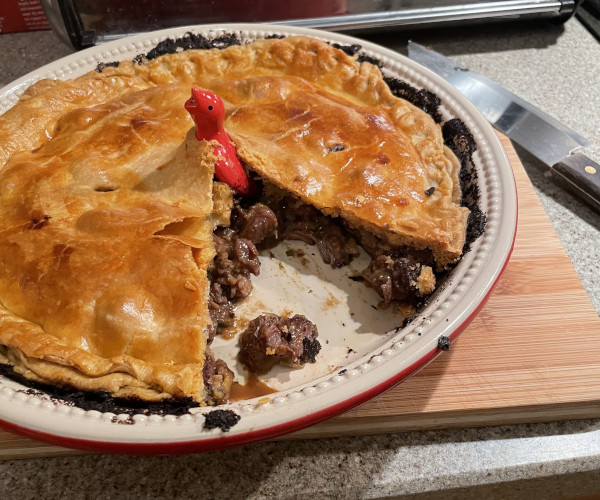
Chicken pie #
As the third pie, I made a chicken pie, this time with both a top and bottom crust. The recipe says it feeds 8, and indeed, there was pie for days.
I followed the recipe for traditional chicken pie from BBC Food.
Despite an initial conversion error the chicken pie was a success. The recipe said to bake at 220C for 45 minutes and after 45 minutes at 330F I wondered why the top still looked raw. When I realized my error, I turned the heat to 425 and baked for another half hour. I had taken a friend's advice and put the pie dish on a metal baking sheet, which I think helped to keep the bottom crust from getting soggy and the pie bird kept the top from getting soggy, despite the accidentally extended bake time. The main consequence was that by the time the pie was ready, everyone was very hungry.
The effort-to-tastiness was not quite worth it. The crust was great, but I found the chicken filling was a lot of work to make and chicken just isn't as rich as beef so the flavor seemed a little weak to me. I would probably make a pie kind of like this again if I have leftovers. I will almost certainly make a pie like this with my turkey leftovers.

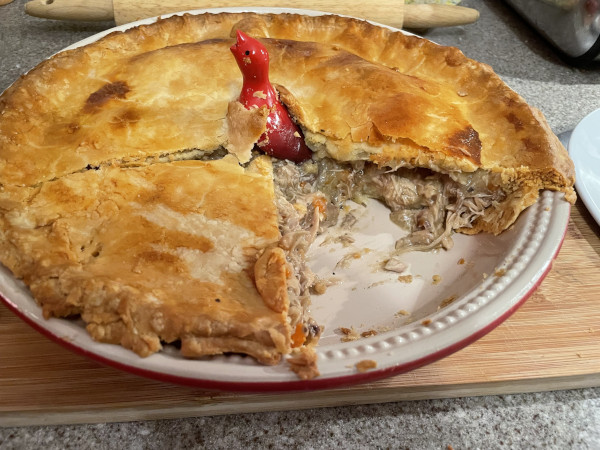
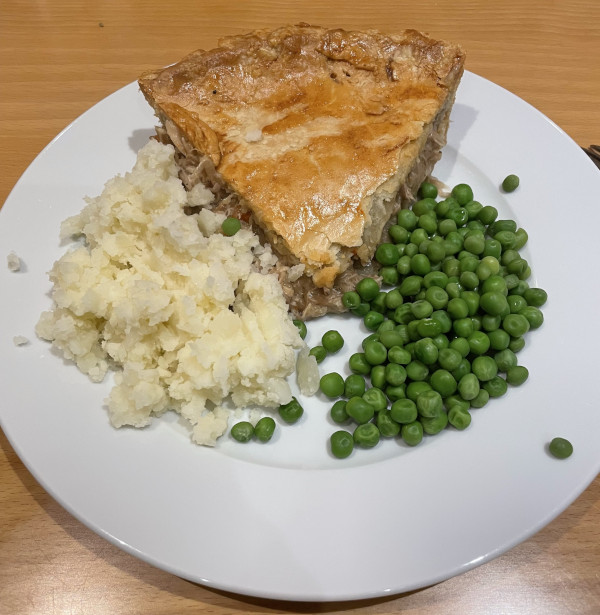
Pumpkin pie #
In honor of the American Thanksgiving holiday, I made a pumpkin pie. I've made pumpkin pie before, but this time I tried out a new technique, pre-baking--also known as "blind baking"--the pie crust. Because pumpkin pie is basically a rich custard and is both very moist and requires a short bake time, the crust needs to be pre-baked if you want it to be crispy.
When you pre-bake a pie crust without the filling, you have to put in something to weigh down the pie crust. None of the instructions I hastily skimmed on Thanksgiving morning mentioned why. I skimmed and then half-assedly followed all of the instructions for blind baking in these three articles
Since I don't have dedicated pie weights, I lined the pie with aluminum foil and weighed that down with sugar, per The Kitchn's instructions, kind of. I realize I mixed things up. I put it in for 15 minutes at 350F and then took out the sugar and put the pie back in, unweighted, to get it crispier. When I took out the weights, the pie bottom seemed kind of wet, like it was partly getting steamed rather than baked, which I didn't like. Then when I put it in with out weights, as some of the Kitchn's procedures suggested to get the final crispiness, it started puffing out!
That's why you need the weights, it turns out! The pie will puff out and if you try to smoosh it back down, it can crack. You definitely need pie weights.
In retrospect, I think I should have read about blind baking ahead of time, and also followed the instructions from the pastry chef. Everything else in those extremely hardcore instructions matched what I've learned from Penguin Cordon Bleu Cookery actually working in a bakery for a while (though that was a very long time ago).
I followed the Simple Pumpkin Pie recipe from Allrecipes for the filling. I made a double portion because my pie dish is huge.
Because the pie was huge, I was extra worried it would crack. Every pumpkin and sweet potato pie I have ever made cracked. How to keep pumpkin pie from cracking saved my pie. My intuition had been that pie cracks because of a sudden change in temperature, so you should keep it in the oven with the heat turned off and let it cool very, very slowly. Turns out, no! You have to take it out while the middle still seems almost wiggly, and then just let it sit on the counter for hours. The link explains why that works. For the first time, I managed to bake a pumpkin pie that didn't crack.
Despite the bottom crust not working out quite as I hoped, the pie as a whole was good. I brought it to Thanksgiving and people seemed to enjoy it. The effort-to-enjoyment was reasonable. It would have been better if I had proper pie weights. I still have half a huge pie, which is too much pie. Luckily, I have a Friendsgiving tomorrow, and I can bring it there.
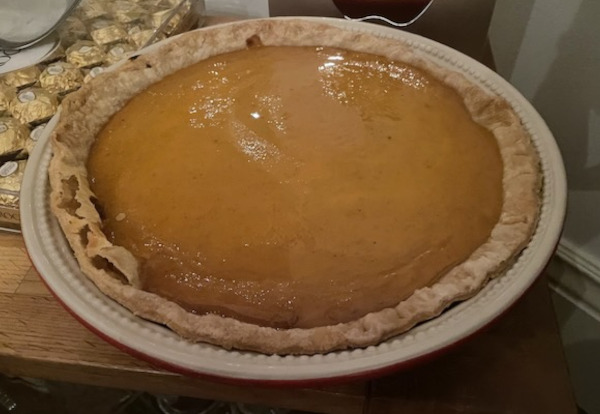
What's next? #
The next pie I make will almost certainly be leftover turkey pie. There's a whole backstory about last year's leftover turkey pie and how I learned that ChatGPT is kind of bad at math. But that's a story for another time.
References #
This is not a recipe blog, and this has not been a long introduction behind which I am hiding a recipe. Nonetheless, if you thought that's what it was and were scrolling to the bottom to find the recipes, here you go. I even put them in alphabetical order for you.
Recipes #
- Cottage pie recipe from BBC Good Food
- Simple Pumpkin Pie recipe from Allrecipes
- Steak pie recipe from BBC Food
- Traditional chicken pie recipe from BBC Food
